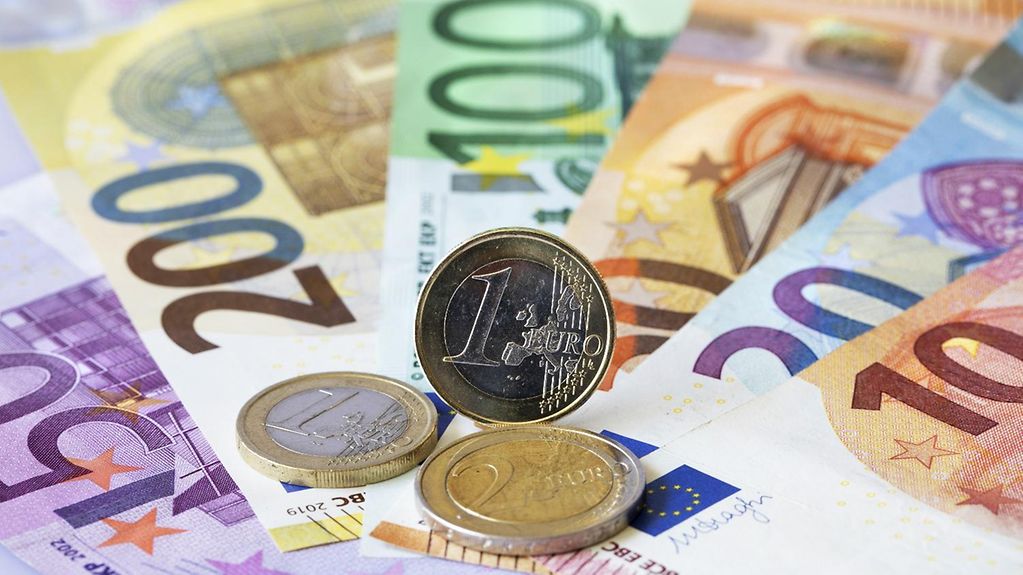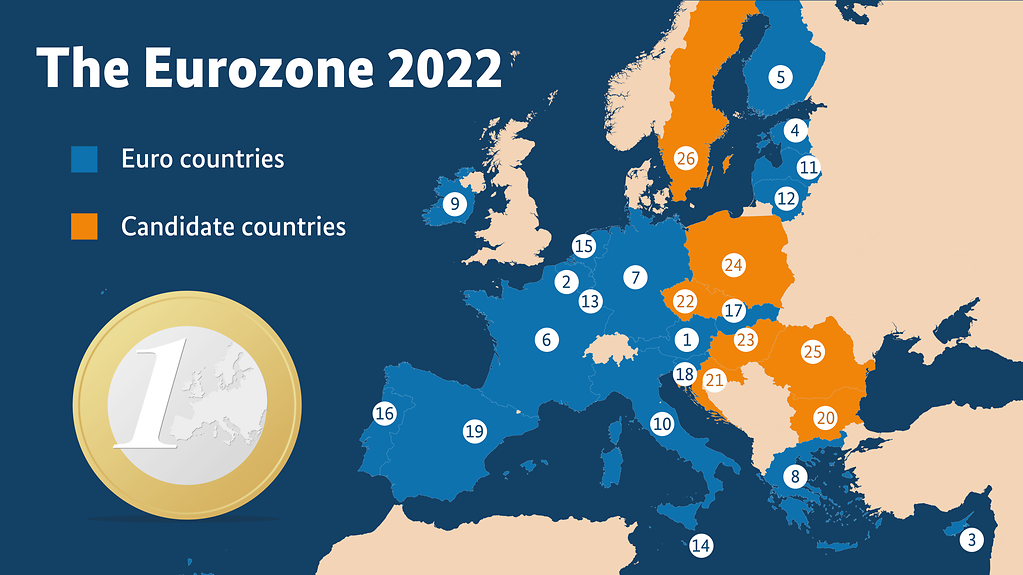Economic and Monetary Union
The euro has been the cash currency of Germany and all other countries of the euro area since January 2002. What originally began in eleven EU member states went on to become a common currency shared by 19 countries with a total population of more than 340 million. Today, the euro is the second most widely used currency in the world.
5 min reading time

80 percent of citizens are in favour of the euro.
Photo: picture alliance/Geisler-Fotopress
The euro is a tangible sign of peace in Europe. Introduced exactly 20 years ago on 1 January 2002, it is now the means of payment in a total of 19 countries in the eurozone.
Many countries in the European Union(EU) are interested in joining the common currency, but they can only be admitted on condition that they meet the EU requirements. The member states aim to move step by step towards a more far-reaching economic and monetary union. This shows that even after 20 years, the eurozone continues to evolve.
Popular support for the euro is at a higher level today than ever before: 80 percent of citizens believe the euro is good for the EU.
The road to the European single currency
Before the euro was finally introduced, a lengthy negotiation process was necessary that lasted several decades. This began back in 1951 with the founding of the European Coal and Steel Community, which is still regarded as the first step towards the creation of the EU and the monetary union. The ECSC was founded by six countries – Belgium, Germany, France, Italy, Luxembourg and the Netherlands. They agreed to create a supranationally regulated market for coal and steel.
The ECSC was so successful that the countries involved decided to integrate other economic sectors, too. This was how the European Economic Community (EEC) and the European Atomic Energy Community (EURATOM) came to be established in 1957.
A European Monetary System (EMS) was created in 1979: this successfully kept the exchange rate of the various currencies in Europe stable. Taking increasingly larger steps, Europe gradually moved towards introducing a common currency. Concrete ideas for realising the later euro were set out in the Delors Committee report as early as 1989, with an initial project being implemented one year later. All restrictions on the movement of capital between member states were lifted.
The euro becomes the common currency
The Maastricht Treaty finally established the Economic and Monetary Union (EMU) in 1993. Binding rules were laid down that the signatory states had to fulfil in order to be able to introduce the single currency. It was at a European Council meeting in Madrid in 1995 that the member states decided on the name of the new currency – it was to be called the “euro”.
On 1 January 1999, the euro was launched as the single currency in eleven EU member states. From that point onwards, only the euro was used as a currency on the financial markets and for electronic payments in Austria, Belgium, Finland, France, Germany, Ireland, Italy, Luxembourg, the Netherlands, Portugal and Spain. Three years later it entered circulation as the cash currency.
Due to the great success of the euro, more states joined the eurozone in subsequent years.

19 EU countries have adopted the euro as their currency.
Under the heading “The Eurozone 2022”, the graphic shows a map of Europe with the euro countries Austria, Belgium, Cyprus, Estonia, Finland, France, Germany, Greece, Ireland, Italy, Latvia, Lithuania, Luxembourg, Malta, the Netherlands, Portugal, Slovakia, Slovenia and Spain, marked in blue. The candidate countries Bulgaria, Croatia, Czech Republic, Hungary, Poland, Romania, Sweden are marked in orange. A one-euro coin can be seen next to the map.
Photo: Bundesregierung
The following states have adopted the euro as their currency: Austria (1), Belgium (2), Cyprus (3), Estonia (4), Finland (5), France (6), Germany (7), Greece (8), Ireland (9), Italy (10), Latvia (11), Lithuania (12), Luxembourg (13), Malta (14), Netherlands (15), Portugal (16), Slovakia (17), Slovenia (18), Spain (19). These states are candidates for accession: Bulgaria (20), Croatia (21), Czech Republic (22), Hungary (23), Poland (24), Romania (25), Sweden (26)
The euro is the second strongest currency in the world
The success of the euro is reflected in its long-term stability. Its inflation rate averaged 1.7 percent up until 2020. By comparison: in Germany the inflation rate was 2.2 percent in the ten years prior to the introduction of the euro. No final figures are available for the pandemic year of 2021 yet, but an average inflation rate of 2.6 percent is expected due to the exceptional circumstances such as shortages of materials, equipment and labour as well as a sharp increase in energy prices. Once these crisis-related factors have been overcome, an inflation rate of 1.8 percent can be expected from 2023 onwards.
The euro is also the second strongest currency worldwide. Its share of global payment transactions is 39 percent – almost on a par with the US dollar (40 percent).
Germany benefits from the strength of the euro
Another advantage is the elimination of exchange rate fees and fluctuations between the euro countries. This has a positive impact for Germany in particular, as an export nation: 40 percent of all its exports go to the eurozone.
Businesses benefit from the common currency, too: it saves costs, thereby helping to maintain jobs and create new ones. It also means companies can expand more easily, which in turn translates into greater product choice and lower prices for consumers.
The single currency makes it easier for 340 million eurozone citizens to save and invest. It also facilitates travel, shopping and trade.
The euro is able to weather crises
The success of the euro is also reflected in its ability to withstand crisis situations. For example, the eurozone countries of Cyprus, Greece, Ireland, Portugal and Spain were particularly affected by the global economic and financial crisis of 2008. The EU institutions took measures to support these countries financially in order to further strengthen the EMU in the long term.
The swift response of the EU and its institutions – especially the European Central Bank (ECB) – enabled a return to an inflation level just below two percent throughout the euro area.
In response to the coronavirus pandemic, the heads of state and government of all EU countries, the European Parliament and the European Commission agreed on a recovery plan in December 2020 to cushion the damage incurred to the economy and society. A total of 2.018 trillion euros is being made available from the long-term EU budget and the temporary programme NextGenerationEU for a greener, more digital and more crisis-proof Europe.
This shows that even in difficult situations, the euro continues to underpin successful collaboration across Europe.
In a joint statement, the members of the Eurogroup look back on 20 years of the euro and set out their priorities for the future of the common currency. The statement was also signed by Federal Finance Minister Christian Lindner.